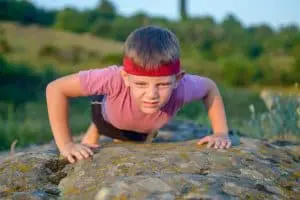Kids Are NOT Little Adults
Every child is different. K-2 students have short legs in relation to their upper body and head that causes them to have a high center of gravity and make them “top-heavy.”
This helps explain why these students fall often and have little success when trying to perform activities such as push-ups and sit-ups. Growth gradually lowers the center of gravity and gives children increased stability and balance. However, it is important to understand how normal growth and development limits student success in many physical activities. To understand this you must know how to determine a students physical maturity.
In the elementary school years, muscular strength increases linearly with chronological age. In other words, as children grow older they become stronger. Pre-adolescent children show few strength differences between the sexes. Boys and girls generally perform similarly in strength activities such as push-ups and sit-ups. In the past, teachers have accepted lower performances from girls even though they are capable of more. Expectations should be similar for elementary school boys and girls.
Consider Height and Weight Differences While Pairing Kids Together
Strength differences do occur among children of widely differing weight and height, regardless of sex. Differences in weight and height should be considered when pairing children for competitive activities such as running together, physical contact, or games that require strength. Problems occur when a student is paired with someone who is considerably taller, heavier or more physically mature and therefore stronger. When matching students for safety reasons, remember that weight and stature are much more important than the gender of the students.
Strength is Important for Motor Skill Success
Strength is an important factor for success in performing motor skills. A study that weighted factors that contribute to the motor performance of children showed that strength or power or both in relation to body size was the most important. High levels of strength in relation to body size (relative strength) helped predict which students were most capable of performing motor skills. The amount of body fat was the fourth-ranked factor in the study and was weighted negatively meaning overweight children were less proficient at learning and performing motor skills. Body fat acts negatively on motor performance by reducing a child’s strength in relation to their body size. Overweight children may be stronger than normal-weight children in absolute terms, but they are less strong when strength is adjusted for body weight. This lack of relative strength makes it more difficult to perform a strength-related task (e.g., push-up or curl-up) compared to normal-weight children. The key point is that overweight youth deserve special consideration to keep them “turned on” to physical activity. Have different expectations for children rather than giving an entire class the same physical challenge.
Physical Maturity for Performance
Teachers have long understood and discussed differences in maturity among students. Youngsters are often referred to as being immature or more mature than other students; but this is usually in reference to the emotional maturity of youngsters. Another type of maturity, skeletal or physical maturity has a strong impact on student performance in physical activities. The method used to identify physical maturity is to compare chronological age to skeletal age. Ossification (hardening) of the bones occurs in the center of the bone shaft and at the ends of the long bones (growth plates). This rate of ossification gives an accurate indication of a child’s maturation and is identified by X-raying the wrist bones and comparing the development of the subject’s bones with a set of standardized X rays. This offers a more accurate indication of a child’s physical maturity. Children whose chronological age is ahead of skeletal age are said to be late (or slow) maturers. On the other hand, if skeletal age is ahead of chronological age, such children are labeled early (fast) maturers.
Studies examining skeletal age consistently show that a five- to six-year variation in maturity exists among youngsters in a typical classroom. For example, third graders (8 year olds) will range in skeletal age from 5 to 11 years. It would be inappropriate to ask a 5-year-old child to perform tasks that 11-year-olds are expected to accomplish. The message here is that even though students in a classroom are about the same age, there are large individual differences in maturity. Monitor and adjust program activities to allow students to progress at a rate suitable to their level of maturity.






